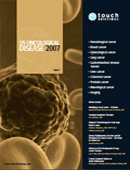ONCOLOGICAL DISEASE (US) – VOLUME 2 ISSUE 2 – FALL 2006


We’d love to hear your feedback on this activity. It helps us to continually improve our products.

Earn and track your CME credits on the go, save articles for later, and follow the latest congress coverage.
Or use a .
Explore the latest in medical education and stay current in your field. Create a free account to track your learning.
